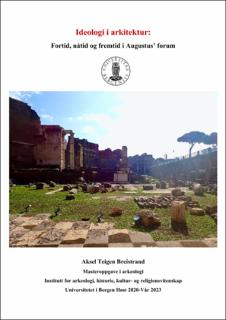Ideologi i arkitektur: Fortid, nåtid og fremtid i Augustus' forum
Master thesis
Permanent lenke
https://hdl.handle.net/11250/3059965Utgivelsesdato
2023-03-23Metadata
Vis full innførselSamlinger
- Master theses [240]
Sammendrag
I denne oppgaven argumenteres det for at Augustus’ forum i Roma var et symbolsk ladet monument der de sentrale temaene i den augusteiske ideologien var utstilt. Det var det siste store byggeprosjektet til Augustus i Roma. Arkitektur, kunst og skulptur på forumet bidro til å legitimere keiserens makt, gjennom assosiajon med Romas mytiske grunnleggere, eksemplariske menn fra fortiden, guddommer knyttet til Augustus’, hans familie og til byen Roma. Ved å bruke minne og legitimitet som teoretiske perspektiver, og ikonologisk og spatial metode vil jeg analysere organiseringen av forumets utforming. Det argumenteres for at forumet var utformet basert på et spatio-mnemonisk prinsipp, nemlig at alle forumets elementer var organisert etter deres forhold til Augstus, noe som dannet en kronologisk koreografi diktert av den augusteiske ideologien. This thesis argues that the Forum of Augustus in Rome was a symbolically charged space where the central themes of the Augustan ideology were exhibited. Vowed in 42 BCE and dedicated forty years later, it was the last of Augustus’ major building programmes in Rome. It became the architectural culmination of his new marble Rome and thus, according to scholarly consensus, providing legitimacy to the sole power of the emperor through architectural and artistic association with Rome’s mythical founders, exemplary men from the past, and the deities connected to Rome itself, the imperial family and the emperor. Against a theoretical background of legitimacy and memory, and using spatial and iconological methods as an approach, I aim to analyze the orientation of and the relationship between the various architectural, artistic, sculptural and decorative elements in the forum. I argue that the organization of the forum is based on a spatio-mnemonic principle; all the elements of the forum are ordered according to their relationship with Augustus creating a chronological choreography strictly narrated by the new world order promoted by Augustus.
